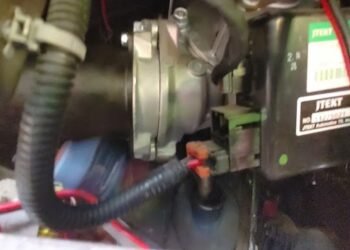Troubleshooting a 2000 Dodge Dakota often involves addressing engine misfires and transmission issues. Common solutions include spark plug replacement and fluid checks.
Owning a 2000 Dodge Dakota can be a rewarding experience, yet it comes with its share of potential issues that require attention. This mid-size pickup truck, popular for its robust performance and versatility, sometimes faces challenges such as engine misfires, transmission problems, and electrical glitches.
As a vehicle owner or a mechanic, understanding these common problems and knowing how to troubleshoot them effectively is essential for maintaining the truck’s longevity and reliability. This guide aims to provide straightforward and practical troubleshooting tips to help you keep your Dakota running smoothly. By focusing on the most frequent issues, we’ll ensure your Dakota remains a dependable companion on the road.
Introduction To The 2000 Dodge Dakota
The 2000 Dodge Dakota emerges as a robust midsize pickup truck. Its versatility blends well with everyday usability. This model stands out in the pre-owned market. Truck enthusiasts often seek it for its durability and performance.
The Allure Of The Model
Compact yet powerful, the Dodge Dakota offers a unique mix. It combines the agility of smaller trucks with the strength of full-sizers. The 2000 Dakota features a range of engine options. These include the efficient V6 and the potent V8. Its towing capacity impresses, making it a favorite for both work and play.
Common Issues Faced By Owners
Despite its strengths, the 2000 Dodge Dakota is not without issues. Owners report several common problems. These include transmission glitches, engine troubles, and electrical concerns. Regular maintenance can help manage these issues. It is important for potential buyers to be aware of them.
Engine Performance Problems
Engine performance problems can turn any driving experience sour, especially with a vehicle like the 2000 Dodge Dakota. Recognizing the signs of engine trouble early on is key to maintaining your truck’s reliability and longevity. Let’s explore the common symptoms and some DIY solutions to keep your Dakota running smoothly.
Symptoms Of Engine Trouble
- Rough idling: Your Dakota shakes or vibrates at a stop.
- Power loss: The truck struggles to accelerate or climb hills.
- Stalling: The engine cuts out unexpectedly while driving.
- Bad fuel economy: More frequent trips to the gas station.
- Check engine light: This dashboard warning is your Dakota’s cry for help.
Diy Solutions
Address engine performance problems with these simple steps:
- Replace air filter: Ensures clean air reaches the engine.
- Check spark plugs: Replace if worn or fouled.
- Inspect fuel injectors: Clean or replace for proper fuel delivery.
- Use fuel additives: Helps clean the fuel system and improve efficiency.
- Check oxygen sensors: Replace if they fail to regulate air-fuel mixture.
Electrical System Glitches
Dodge Dakotas from the year 2000 often face electrical challenges. These issues can cause headaches for vehicle owners. Understanding common electrical problems helps in quick troubleshooting. Let’s explore how to identify and fix these glitches.
Identifying Electrical Issues
Electrical troubles in a Dodge Dakota may show as dim lights, dead batteries, or faulty starters. A blown fuse often signals a deeper issue. Regular checks keep these problems at bay. Use a multimeter to test battery voltage. Look for loose connections or corroded wires. A professional diagnostic tool spots hidden faults.
Easy Fixes
Sometimes, the solution is simple. Start with the battery. Ensure terminals are clean and tight. Replace old batteries. Check fuses next. A blown fuse needs immediate replacement. Consult the owner’s manual for the correct type.
- Inspect wires: Look for damage or wear.
- Secure connections: Tighten any loose connections.
- Replace relays: Swap out faulty relays as needed.
For persistent issues, seek professional help. Regular maintenance prevents electrical problems. Keep your Dodge Dakota running smoothly with these tips.
Transmission Troubles
The 2000 Dodge Dakota is a sturdy truck, but like any vehicle, it may experience transmission issues. Understanding the signs and knowing some home repair tips can save time and money. Let’s dive into the common transmission troubles of this model.
Signs Of Transmission Failure
Recognizing early signs of transmission failure is crucial for your Dodge Dakota’s health. Here are key indicators:
- Delayed Engagement: The truck takes time to move after shifting.
- Slipping Gears: The truck changes gears without command.
- Fluid Leaks: Reddish fluid under the truck signals trouble.
- Unusual Noises: Whining or clunking sounds aren’t good signs.
- Warning Light: The check engine light may signal transmission issues.
Home Repair Tips
Some transmission problems can be fixed at home. Follow these steps:
- Check Fluid Level: Low fluid can cause shifting problems.
- Replace Filter: A clogged filter can lead to poor performance.
- Use Correct Fluid: Always use the recommended transmission fluid.
- Adjust Bands: Incorrectly adjusted bands can cause slipping.
- Check Sensors: Faulty sensors may affect transmission behavior.
Note: Always consult the vehicle’s manual or a professional before attempting repairs.
Suspension And Steering Challenges
The 2000 Dodge Dakota boasts robust performance. Yet, it may face suspension and steering issues. A smooth ride depends on a well-maintained suspension and steering system. Let’s explore common challenges and quick fixes for these systems.
Common Suspension Issues
Suspension problems can affect your Dakota’s ride quality. Here are frequent issues to watch for:
- Worn shocks or struts: These parts dampen road bumps. Replace them if damaged.
- Broken springs: Springs support your truck’s weight. Check for sagging or breakage.
- Bent or worn control arms: These components affect wheel alignment. Inspect for wear or damage.
- Worn bushings: Bushings cushion metal parts. Look for cracking or deterioration.
Regular inspections prevent bigger issues. Address these signs early for a smooth drive.
Steering System Quick Fixes
A responsive steering system is vital for safety. Here are some quick fixes:
| Issue | Quick Fix |
|---|---|
| Loose steering | Check tie rods and adjust if loose. |
| Stiff steering wheel | Add power steering fluid if low. |
| Noisy steering | Inspect power steering pump for issues. |
| Wandering wheels | Align wheels and balance for control. |
Fix these common steering problems and enjoy a safe, controlled drive in your Dodge Dakota.
Cooling System Maintenance
Maintaining your 2000 Dodge Dakota’s cooling system is crucial. A well-functioning system keeps the engine at the right temperature. It prevents overheating, a common issue with older vehicles. Regular check-ups and proper care are key.
Overheating Problems
Overheating can damage your Dakota’s engine. The symptoms include steam from the hood and a high temperature gauge reading. Immediate action is necessary to avoid costly repairs.
- Check the radiator cap seal for wear.
- Inspect hoses for leaks or cracks.
- Ensure the thermostat opens and closes properly.
- Look at the fan belt for signs of damage.
- Check the coolant level regularly.
Coolant System Care
Proper coolant system care extends engine life. It involves a series of simple, yet important, steps.
- Use the correct coolant type.
- Mix antifreeze and water in the right ratio.
- Flush the system every two years.
- Replace old hoses as needed.
- Regularly inspect for leaks.
Following these steps helps maintain your Dakota’s peak performance. Neglect can lead to breakdowns and high repair bills.
Brake System Insights
The brake system is crucial for your Dodge Dakota’s safety. It requires regular checks and maintenance. Learn to spot performance issues early. Keep your vehicle safe and responsive.
Brake Performance Red Flags
Pay attention to these warning signs:
- Squealing or grinding noises when you press the brake pedal.
- Vibrations in the steering wheel during braking.
- A soft or spongy brake pedal means air in the system.
- Longer stopping distances can signal worn brake pads.
- Warning lights on your dashboard should not be ignored.
Maintaining Your Brakes
Follow these steps for effective brake care:
- Check brake pads and rotors for wear every 6,000 miles.
- Replace brake fluid every two years to prevent corrosion.
- Inspect brake lines and hoses for leaks or damage regularly.
- Clean and adjust brake components to ensure smooth operation.
Proper maintenance keeps your Dakota’s brakes sharp and reliable.

Credit: www.amazon.com
Fuel System Fixes
Owners of the 2000 Dodge Dakota often face fuel system challenges. Keeping the fuel system in check is vital for the truck’s performance. Let’s explore some of the best practices and troubleshooting tips for maintaining an efficient fuel system.
Fuel Efficiency Tips
Boosting fuel efficiency is crucial for your Dakota. It saves money and helps the engine.
- Regular maintenance: Keep your Dakota running smoothly.
- Check tire pressure: Proper inflation improves mileage.
- Replace air filters: Clean filters enhance airflow to engines.
- Use recommended fuel: Stick to manufacturer’s fuel specifications.
Solving Fuel System Issues
A well-maintained fuel system ensures your Dakota’s reliability. Follow these steps to troubleshoot common problems.
- Inspect fuel lines: Look for leaks or damage.
- Test fuel pump: Ensure it delivers correct pressure.
- Clean fuel injectors: Remove buildup for better performance.
- Replace fuel filter: A clogged filter can restrict flow.
| Issue | Solution |
|---|---|
| Engine sputters | Check fuel pump operation |
| Poor acceleration | Clean or replace injectors |
| Hard starts | Inspect fuel lines and filter |
Preventive Measures And Regular Maintenance
Maintaining your 2000 Dodge Dakota is key to its longevity. Simple, regular checks and services can prevent big problems. This section covers essential preventive measures and regular maintenance tasks. Follow these to keep your Dakota running smoothly for years.
Scheduled Maintenance Checklist
Sticking to a maintenance schedule keeps your Dakota in top shape. Here’s what you need to do:
- Oil Changes: Change every 3,000 to 5,000 miles.
- Tire Rotation: Every 6,000 miles to ensure even wear.
- Brake Inspection: Check brakes every 10,000 miles.
- Fluid Levels: Monthly checks on coolant, brake, and power steering fluids.
- Air Filter: Replace every 12,000 miles for better engine performance.
Longevity Tips For Your Dakota
Follow these tips to extend the life of your 2000 Dodge Dakota:
- Regularly clean the interior and exterior. This prevents rust and wear.
- Use quality parts for repairs. They last longer and perform better.
- Drive gently. Avoid hard starts and stops to reduce strain on the engine and brakes.
- Keep it garaged if possible. This protects it from weather-related damage.
- Address small issues quickly. This prevents them from becoming big problems.
These simple steps will keep your Dakota reliable for years. Stay proactive about maintenance and care.

Credit: www.youtube.com
Credit: repairpal.com
Frequently Asked Questions
What Would Cause Dodge Dakota Not To Start?
A Dodge Dakota may not start due to a dead battery, faulty ignition switch, failed starter, empty fuel tank, or a defective fuel pump.
What Are Common Dodge Dakota Transmission Problems?
Common Dodge Dakota transmission problems include shifting issues, transmission slippage, fluid leaks, and failure to engage. Owners often report difficulty in changing gears. Regular maintenance helps mitigate these issues.
Why Does My Dodge Dakota Make A Clicking Sound When Accelerating?
Your Dodge Dakota may emit a clicking sound while accelerating due to worn CV joints, loose wheel bearings, or low engine oil. Regular inspections can help identify and resolve these issues promptly, ensuring smooth and safe driving.
How Much Does It Cost To Replace A Transmission In A Dodge Dakota?
Replacing a transmission in a Dodge Dakota typically costs between $1,800 and $3,500. Factors such as model year and labor can affect the final price.
Why Is My Dodge Dakota Not Starting?
Possible causes include a dead battery, faulty ignition switch, or a malfunctioning starter motor. Check for any electrical issues first.
Conclusion
Troubleshooting your 2000 Dodge Dakota doesn’t have to be a daunting task. Armed with the insights from this post, you’re now equipped to tackle common issues with confidence. Remember, regular maintenance is key to your Dakota’s longevity. Keep this guide handy, and your trusty truck will continue to serve you well on the road ahead.
Drive safely and happy troubleshooting!
















